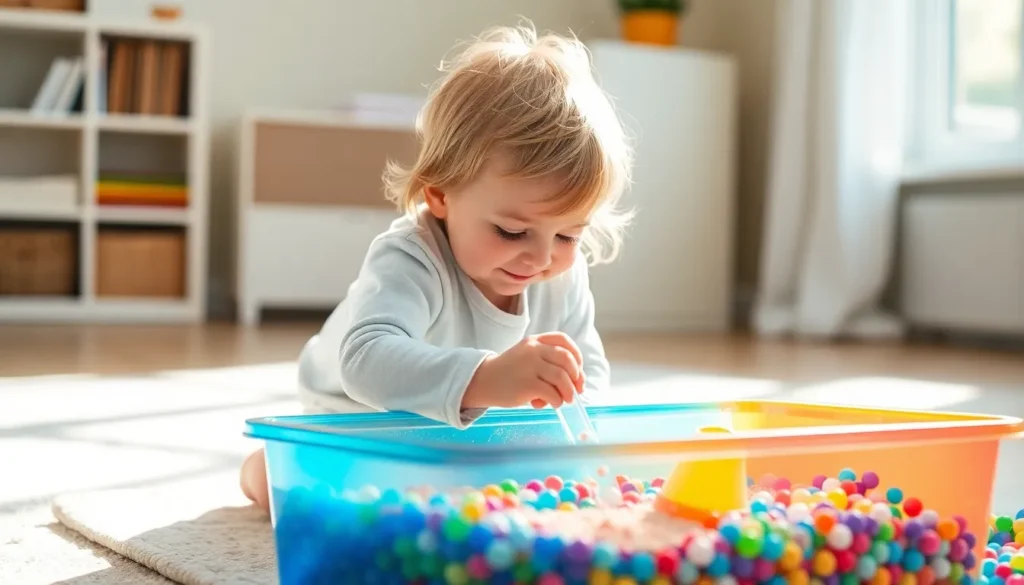Table of Contents
ToggleIn the world of childhood learning, Montessori sensory activities stand out like a unicorn in a field of horses. These engaging experiences not only tickle little ones’ senses but also lay the groundwork for their cognitive development. Imagine a child discovering the tactile joy of sand, the soothing sound of water, or the delightful aroma of spices. Not only do these activities keep kids entertained, but they also turn everyday moments into magical learning opportunities.
Parents and educators are increasingly realizing that sensory play isn’t just child’s play; it’s a vital part of early education. By tapping into the five senses, children explore their environment, develop fine motor skills, and enhance their creativity. So, if you’re ready to sprinkle some sensory magic into your child’s routine, buckle up! Montessori sensory activities are about to make learning feel like a thrilling adventure.
Overview of Montessori Sensory Activities
Montessori sensory activities play a crucial role in early childhood development. Engaging children in these activities nurtures their cognitive growth through hands-on experiences. Exploring various textures, sounds, and scents enhances sensory awareness, allowing children to make connections with their surroundings.
These activities encourage fine motor skills development. Children manipulate objects and materials, improving their dexterity and coordination. As they interact with different materials, their creativity flourishes. Engaging in activities like pouring, scooping, or assembling also fosters problem-solving skills.
Parents and educators increasingly recognize the importance of incorporating sensory play in learning routines. Research shows that sensory-rich environments significantly impact a child’s ability to explore and understand the world. By offering diverse sensory experiences, children learn to engage their senses, enhancing overall learning outcomes.
Activities can include creating sensory bins filled with various materials like sand, water beads, or rice. Introducing sound jars containing different objects encourages auditory exploration. Scavenger hunts focusing on touch and smell stimulate curiosity and discovery.
Incorporating these activities into daily routines creates a hands-on learning environment. By providing opportunities for sensory exploration, parents and educators lay the foundation for essential skills. Montessori sensory activities not only entertain but also transform everyday moments into valuable educational experiences.
Benefits of Montessori Sensory Activities

Montessori sensory activities offer numerous advantages for children’s development. These activities are instrumental in enhancing cognitive skills through engaging experiences.
Enhancing Cognitive Development
Hands-on experiences significantly boost cognitive growth. Engaging with diverse textures, sounds, and scents allows children to build critical thinking. Connecting these sensory experiences to their surroundings fosters deeper understanding. Research indicates that sensory-rich environments enhance attention span and memory retention. Learning through play not only captures children’s interest but also encourages exploration. Activities like sensory bins and sound jars provide opportunities for discovering cause and effect. Elements of sensory play increase curiosity, enabling children to ask questions and seek answers. Participating in these activities cultivates a love for learning while developing essential cognitive abilities.
Improving Fine Motor Skills
Fine motor skills improve through manipulation of various materials. Engaging with tools such as tongs, scoops, and textured objects enhances dexterity. Children gain better hand-eye coordination from sorting and pouring activities. Grasping different items strengthens the small muscles in their hands. Research confirms that tactile experiences significantly contribute to physical development. Sensory activities require children to use their fingers and hands, promoting precise movement. Incorporating these playful experiences into routines prepares children for future tasks like writing. Well-developed fine motor skills also support independence in daily life activities.
Types of Montessori Sensory Activities
Montessori sensory activities encompass various engaging types that promote learning through exploration.
Practical Life Activities
Practical life activities focus on basic skills essential for daily living. Activities like pouring, sweeping, and buttoning teach children coordination and concentration. These tasks enhance their ability to take care of themselves and their environment. Engaging with these activities fosters independence and helps develop fine motor skills. They find joy in completing tasks, leading to a sense of accomplishment. By encouraging involvement in practical life, children connect sensory experiences with real-world applications.
Nature-Based Sensory Experiences
Nature-based sensory experiences utilize elements from the environment to provide enriching learning moments. Outdoor explorations encourage children to interact with plants, stones, and different textures. Activities like nature walks allow them to collect leaves and marvel at the variety in shapes and colors. Engaging with natural materials stimulates curiosity and enhances sensory awareness. Such experiences foster an appreciation for the environment and help deepen understanding of natural phenomena.
Creative Sensory Play
Creative sensory play incorporates artistic elements along with sensory exploration. Activities such as finger painting, clay modeling, and water play encourage self-expression and fine motor skill development. Children explore colors, shapes, and different materials, fostering creativity. These hands-on experiences provide opportunities to experiment and create freely. They establish connections between imagination and tactile experiences. Engaging in creative sensory play nurtures problem-solving skills and critical thinking while enhancing overall cognitive development.
Tips for Implementing Montessori Sensory Activities at Home
Implementing Montessori sensory activities at home enhances children’s learning experiences. Key strategies focus on creating inviting spaces and selecting appropriate materials.
Creating a Sensory-Friendly Environment
Establish a designated area for sensory play. This space should include soft flooring, such as rugs or mats, to ensure comfort. Natural lighting enhances the ambiance, while calming colors promote focus. In addition, incorporating open shelves allows easy access to materials. Arranging materials by type ensures children can engage independently. Frequent rotation of items keeps the play stimulating and fresh, encouraging exploration.
Selecting Appropriate Materials
Choose materials that stimulate various senses. Textures like sand, water beads, and rice provide tactile experiences. Incorporating items such as leaves, stones, and shells introduces natural elements. Sound jars filled with diverse materials foster auditory exploration. When selecting colors, opt for a range of shades to enhance visual stimulation. Always prioritize safety; select non-toxic and age-appropriate items. Involving children in choosing materials increases their engagement and investment in the activities.
Montessori sensory activities play a vital role in early childhood development. These hands-on experiences not only captivate children’s attention but also enrich their learning journey. By engaging with various materials and environments, children enhance their cognitive abilities and fine motor skills.
Incorporating sensory play into daily routines fosters curiosity and creativity. It allows children to explore their surroundings while building essential skills. As parents and educators embrace these activities, they contribute to a nurturing environment that supports holistic growth. Ultimately, the benefits of Montessori sensory activities extend far beyond playtime, laying the groundwork for a lifetime of learning and exploration.


